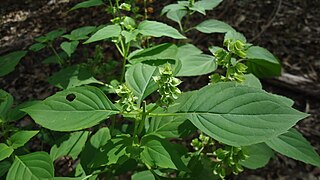
Basil, also called great basil, is a culinary herb of the family Lamiaceae (mints).

Ocimum is a genus of aromatic annual and perennial herbs and shrubs in the family Lamiaceae, native to the tropical and warm temperate regions of all 6 inhabited continents, with the greatest number of species in Africa. It is the genus of basil and the name is from the Ancient Greek word for basil, ὤκιμον (ṓkimon). Its best known species are the cooking herb cooking basil, O. basilicum and the medicinal herb tulsi, O. tenuiflorum.

Ocimum tenuiflorum, commonly known as holy basil or tulsi, is an aromatic perennial plant in the family Lamiaceae. It is native to the Indian subcontinent and widespread as a cultivated plant throughout the Southeast Asian tropics.

Ocimenes are a group of isomeric hydrocarbons. The ocimenes are monoterpenes found within a variety of plants and fruits. α-Ocimene and the two β-ocimenes differ in the position of the isolated double bond: it is terminal in the alpha isomer. α-Ocimene is cis-3,7-dimethyl-1,3,7-octatriene. β-Ocimene is trans-3,7-dimethyl-1,3,6-octatriene. β-Ocimene exists in two stereoisomeric forms, cis and trans, with respect to the central double bond. The ocimenes are often found naturally as mixtures of the various forms. The mixture, as well as the pure compounds, are oils with a pleasant odor. They are used in perfumery for their sweet herbal scent, and are believed to act as plant defense and have anti-fungal properties. Like the related acyclic terpene myrcene, ocimenes are unstable in air. Like other terpenes, the ocimenes are nearly insoluble in water, but soluble in common organic solvents.

Thai basil is a type of basil native to Southeast Asia that has been cultivated to provide distinctive traits. Widely used throughout Southeast Asia, its flavor, described as anise- and licorice-like and slightly spicy, is more stable under high or extended cooking temperatures than that of sweet basil. Thai basil has small, narrow leaves, purple stems, and pink-purple flowers.

Lemon basil, hoary basil, Thai lemon basil, or Lao basil, is a hybrid between basil and American basil. The herb is grown primarily in northeastern Africa and southern Asia for its fragrant lemon scent, and is used in cooking.

African blue basil is a hybrid basil variety, a cross between camphor basil and dark opal basil. It is one of a few types of basil that are perennial. African blue basil plants are sterile, unable to produce seeds of their own, and can only be propagated by cuttings.
Spicy globe basil is a cultivar of Ocimum basilicum. Unlike some better known basils, it grows in the form of a tidy, compact bush, more suitable for gardens and small pots than most varieties. The small, densely growing leaves are used in the same way as the leaves of other sweet basil varieties.
Lettuce leaf basil is a large-leaf variety of Ocimum basilicum. The large, crinkled leaves, which grow on the short, wide plant, are sweet, but not as strong as other sweet basils. This makes them particularly suitable for tossing into salads or wrapping fish, chicken or a rice stuffing for grilling.
Mrs. Burns' Lemon basil is an heirloom cultivar of sweet basil from New Mexico in the United States. Compared to lemon basil, which is a different species of basil, in Mrs. Burns lemon basil the lemon flavor is more intense, the leaves are larger, and the plant itself is more robust.

Nufar basil is the first variety of sweet basil that is resistant to fusarium wilt. Fusarium wilt is a disease that causes sudden wilting and death in multiple species, including basil. It is caused by the fungus Fusarium oxysporum f. sp. basilicum, which attacks the xylem in the stem, blocking water uptake and leading to a characteristic sudden leaf wilt that does not respond to watering. Nufar basil is resistant to fusarium wilt, remaining asymptomatic even when infected. It was released in 1999 in Israel by the breeders of the Agricultural Research Organization, and commercialized by Genesis Seeds.
Fino verde basil is a cultivar of Ocimum basilicum. Some sources list Fino verde as a synonym for spicy globe basil, while others list it as a separate variety. Fino verde grows as a small, dense bush, suitable for gardening or pots. The leaves are much smaller than those of most basils. The flavor is similar to that of sweet basil, but stronger and spicier. The leaves are easy to use in cooking because they can be used twigs and all, unlike basils with larger leaves.
Magical Michael basil is a cultivar of Ocimum basilicum. The plants reliably grow to 15 inches tall and 16–17 inches wide. This degree of uniformity is unusual in basil varieties. The flowers of the plant are also unusual, with purple calyxes and white corollas. The flavor is similar to sweet basil. Magical Michael is a past winner of the All-American Selection award.
Mammoth basil is a lettuce leaf basil variety, originating from Italy. Like many culinary basils, it is a cultivar of Ocimum basilicum. The plant grows to approximately 18 inches tall, and produces large ruffled leaves with a jagged edge. The flavor is similar to, but stronger than the flavor of Genovese basil. The leaves are used in pesto or whole, in salads.
Purple ruffles basil is a cultivar of Ocimum basilicum. The dark purple leaves are used in pesto or as a garnish. This attractive basil variety has won multiple awards for its beauty, flavor and ease of cultivation, including the Mississippi Medallion and All-American Selection awards. This variety of purple leaf basil is characterized by its deep ruffles and decorative serrated leaf margins.
Osmin purple basil is a cultivar of Ocimum basilicum with dark purple leaves. It is distinguished from other purple basil varieties by smaller, darker leaves. It has the darkest leaves of any purple basil variety. The plant averages a height of 20 inches (51 cm) and is grown in sunny or partially sunny environments.

Methyl cinnamate is the methyl ester of cinnamic acid and is a white or transparent solid with a strong, aromatic odor. It is found naturally in a variety of plants, including in fruits, like strawberry, and some culinary spices, such as Sichuan pepper and some varieties of basil. Eucalyptus olida has the highest known concentrations of methyl cinnamate (98%) with a 2–6% fresh weight yield in the leaf and twigs.

Greek basil is a flowering herb and cultivar of basil.










